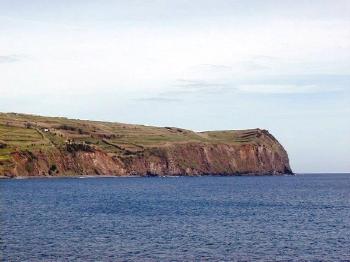Faial, The Azores (Açores), Portugal (March 2001)

Wealthy transatlantic yachters adopted Horta as a convenient stopping point between Europe and North America in recent decades (map). Their graceful sailboats line the town’s marina. While there, their crews also leave colorful graffiti on the harbor barriers to commemorate their oceanic voyages. The mosaic of color on the seawall at the back of this photograph shows some of their handiwork.
The volcano in the background actually rises on the neighboring island of Pico. Nonetheless it provides a splendid backdrop to Horta’s harbor. We had arrived earlier in the day from Pico by ferry [see my Faial – Pico Ferry page].
Ponta da Espalamaca

The marina’s protective barrier provides excellent unobstructed views of Ponta da Espalamaca (map). This promontory north of Horta defines part of the harbor’s shape. It combines with Monte da Guia to the south (map), plus a man-made seawall closer-in, to protect the harbor from ocean waves. Farms and fields dot the rolling hills atop the point. Then the plain drops suddenly into the sea.
Horta Shoreline

A waterfront sidewalk along Horta’s Avenida Diogo de Teive provided a relaxing place to contemplate the scenery on a sunny spring day. This particular stretch of the promenade led northward away from the yacht harbor. Ponta da Espalamaca appears in the background to the right.
Castelo de Santa Cruz

The Castelo de Santa Cruz (map) sits imposingly near the center of Horta’s harbor. The Portuguese built this fortress in the 16th Century to protect the island from marauders. Nonetheless, enemies seized it a number of times. The Spanish grabbed it first, followed by Sir Walter Raleigh and finally by troops loyal to Pedro IV. Today it serves no defensive purpose whatsoever. Instead a luxury hotel occupies the castle walls.
The marina and Ponta da Espalamaca appear in the distance.

Leave a Reply